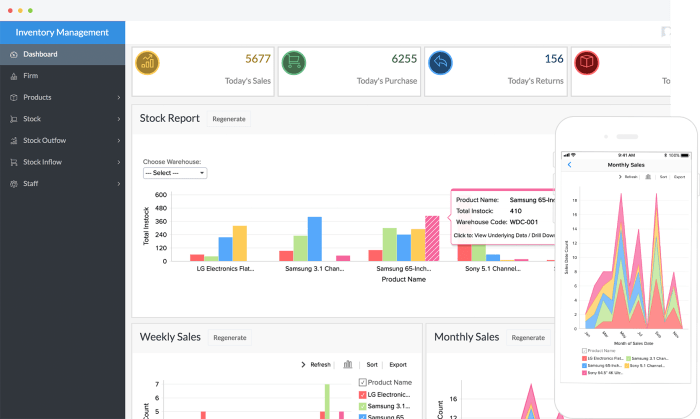Inventory and sales software are crucial tools for businesses of all sizes. They streamline operations, improve efficiency, and boost profitability. This guide dives deep into the world of inventory management and sales software, exploring various types, features, benefits, and considerations for choosing the right solution for your needs. We’ll also touch on essential aspects like integration and implementation.
Understanding Inventory and Sales Software
Inventory management software tracks and manages your stock levels, from raw materials to finished goods. Sales software, on the other hand, handles the entire sales process, from order processing to invoicing and customer relationship management (CRM). Modern systems often integrate these functions, offering a unified platform for inventory and sales management.
Types of Inventory and Sales Software
Different types of businesses have unique needs. Software solutions cater to various industries and scales. Some popular types include:

Source: clickup.com
- Cloud-based software: Accessed via the internet, offering flexibility and scalability.
- On-premises software: Installed on your company’s servers, providing more control but potentially higher upfront costs.
- Point-of-Sale (POS) systems: Designed for retail businesses, focusing on handling transactions and inventory at the point of sale.
- Enterprise Resource Planning (ERP) systems: Comprehensive solutions that integrate various business functions, including inventory and sales, with broader financial management.
Key Features to Look for
When evaluating inventory and sales software, consider these crucial features:

Source: altexsoft.com
Inventory Management Features
- Real-time inventory tracking: Accurate stock levels are vital for avoiding overstocking and stockouts.
- Barcode and RFID scanning: Streamlines inventory input and reduces errors.
- Automated reordering: Prevents stock shortages and optimizes inventory levels.
- Inventory forecasting: Predicts future demand and adjusts inventory accordingly.
- Multi-location management: Handles inventory across multiple warehouses or stores.
Sales Management Features
- Order management: Efficiently handles order processing, fulfillment, and tracking.
- Customer relationship management (CRM): Manages customer interactions and data.
- Reporting and analytics: Provides insights into sales performance, inventory trends, and profitability.
- Invoicing and billing: Automates invoicing and payment processing.
- Sales forecasting: Predicts future sales and adjusts strategies accordingly.
Benefits of Using Inventory and Sales Software
Implementing inventory and sales software brings significant advantages:
- Increased efficiency: Automates tasks, reduces manual errors, and speeds up processes.
- Improved accuracy: Provides real-time data, reduces errors, and improves decision-making.
- Enhanced profitability: Optimizes inventory levels, reduces waste, and boosts sales.
- Better customer service: Streamlines order fulfillment and improves communication with customers.
- Data-driven decision-making: Provides valuable insights into business performance.
Choosing the Right Software for Your Business
Selecting the ideal inventory and sales software depends on several factors, including business size, industry, and specific needs. Consider your budget, scalability requirements, and integration needs.
Implementation and Integration
Smooth implementation is key. Thorough planning, staff training, and data migration are crucial. Integration with existing systems (e.g., accounting software) is also essential for seamless workflow.
Frequently Asked Questions (FAQ)
- How much does inventory and sales software cost? Costs vary significantly based on features, vendor, and the scale of the system.
- How long does it take to implement inventory and sales software? Implementation timelines depend on the complexity of the system and the level of customization required.
- What are the risks of implementing inventory and sales software? Data migration challenges, staff training, and system integration issues are potential risks.
- What are some popular inventory and sales software providers? (List a few reputable providers here – e.g., Xero, QuickBooks, NetSuite). Research is vital for finding the right fit.
Conclusion
Implementing the right inventory and sales software is a strategic investment for any business. It can dramatically improve operational efficiency, accuracy, and profitability. Thorough research, careful planning, and a focus on integration are crucial for success.
Call to Action (CTA)
Ready to streamline your inventory and sales processes? Explore our recommended software solutions and take the first step towards a more efficient and profitable business. [Link to a relevant resource page or product]
FAQ Summary
What are the typical costs associated with implementing inventory and sales software?
Software costs vary greatly depending on the features, functionalities, and vendor. Licensing fees, implementation costs, and ongoing maintenance fees should be considered when evaluating total cost of ownership. Businesses should also factor in potential training costs for staff to use the new system effectively.
How does this software integrate with existing accounting systems?
Many inventory and sales software solutions are designed to integrate with popular accounting software through APIs. This seamless integration ensures data consistency and avoids manual data entry, streamlining the financial reporting process.
What are the key benefits of using cloud-based inventory and sales software?
Cloud-based solutions offer accessibility from anywhere with an internet connection. This allows for remote access and collaboration, increasing flexibility and responsiveness for businesses. Moreover, cloud solutions typically have lower upfront costs and require less in-house IT support compared to on-premise software.